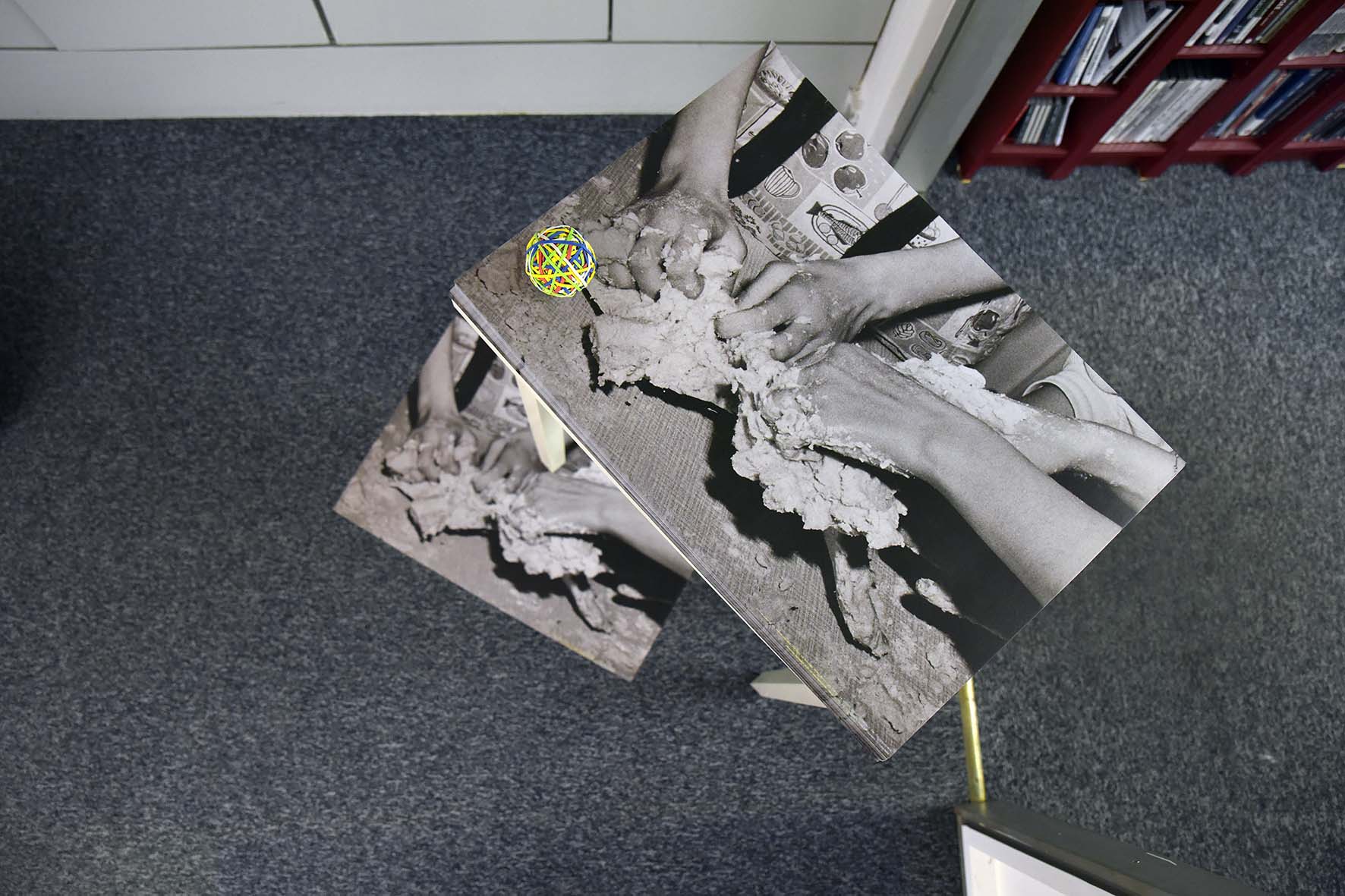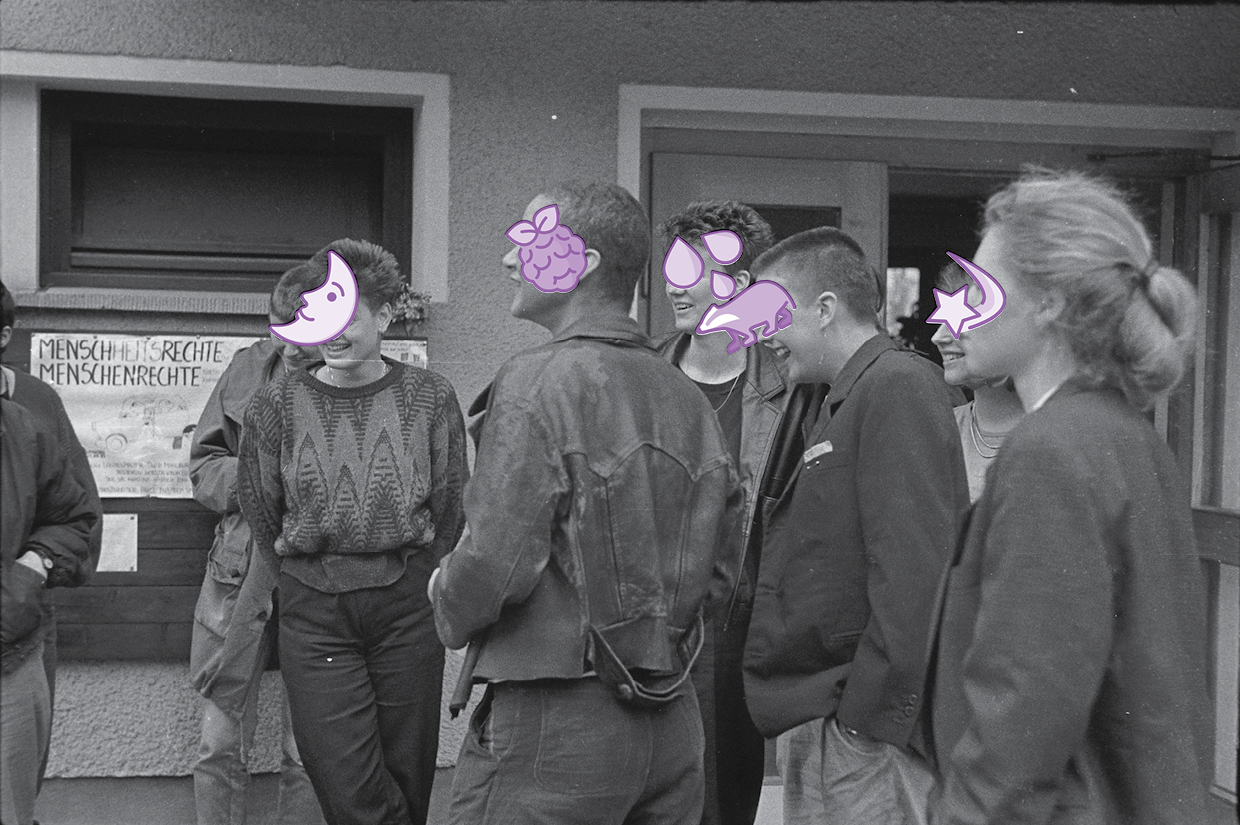вместе





Lach und Flüster — 3tot,
O.T. — Erweiterte Orgasmus Gruppe,
Nazis Raus — Namenlos,
Chemnitz Stadt— Baumarkt
и Ли Стивенс из Raumerweiterungshalle collective
Редактура: Вика Кравцова
Произведен в контексте «wild recuperations.materials» из
ниже: Художественные исследования в архиве оппозиции ГДР, сотрудничество между Берлином и архивом ГДР Оппозиции/Robert-Havemann-Gesellschaft e.V.
Йена, Пентакост, 1989 год.
Изображение справа: Самира Кенави, основательница Архива GrauZone.
Фото: Керстин Баарманн, архив GrauZone в Архиве оппозиции в ГДР.

Лесбийская организация в ГДР [1], 1989, GrauZone

он уже был там, и мы были включены в него.

Фото: Пеа Леманн, архив GrauZone в Архиве ГДР Оппозиции
Я отдала Sonntagsclub все свои файлы с моими экзаменационными записями и т.д. Они сейчас в Schwules Museum. Тогда вы должны были пройти медицинские осмотры, чтобы определить были ли вы транссексуалкой или нет; это решали невролог и психиатр. В восточной части, Внутренний приказ по Транссексуалам [6] - такое замечательное слово - был принят за три года до Транссексуального Акта [7] Западной Германии.
Вы подавали заявку своему семейному врачу, и она отправлялась в Министерство внутренних дел, которое занималось жизненно важными записями, а затем в министерство здравоохранения. Затем заявка отправлялась дальше по своему социалистическому курсу, туда-сюда. Вы должны были быть обследованы, обычно это была медицинская экспертиза. Здесь положение могло быть улучшено: мы думали о том, как мы могли бы организовать медицинское обследование по-другому. Если результат был положительным, вы начинали гормональную терапию в Charité; операция проходила в Лейпциге с доктором Профессором Дитрих. Но вам не нужно было беспокоиться об этом. В ГДР гражданский статус иногда изменялся еще до операции.
В целом, я была более-менее вовлечена в гей-лесбийскую сцену, я была в гей сцене, потому что геи были более приветливы. Вообще-то, я была в гей и транс сцене. И потому что я была в Sonntagsclub, мы не разделяли вещи так. Как я уже говорила, лесбиянки были теми, кто исключил меня, поэтому я не чувствовала себя с ними комфортно.
Поскольку у нас не было такого, мы не задавали себе этих вопросов. Я думаю, из-за этого возникло бы много споров: “Нет, это парень, я не хочу этого!” и “Была перерегистрация! Дайте женщине пройти!”. У нас никогда не было такой ситуации. Но, я думаю, это было бы достаточно тяжело, как и сегодня.
Надя Шалленберг
Транссексуальныx женщин исключают больше всего: они теряют больше в социальном и профессиональном плане. Я разбиралась с этим открыто и боролась за наши права, за наше социальное и политическое признание. И мы называли то, что делали - транс сила (tranny power). Мы действительно начали с бума. Это было дикое время, хорошие времена. Вы даже не представляете, какие великие идеи у нас были, но что стало с ними в итоге, просто печально насколько буржуазной стала сцена. Если бы вы были лесбиянкой или транс-персоной в 90-х, вы были левыми (либеральными). Так оно и было. Вы были политически прогрессивны, да, и это больше не так сегодня.
Беттина Дзиггель
(Министерство государственной безопасности, Руководство 1/76 по развитию и лечению операционных процедур), 1976
Секретное руководство 1/76 по лечению оперативных процедур регулирует тайную полицейскую деятельность Штази против политических противников. Надежная защита общества и гарантия его комплексной внутренней безопасности в ГДР требует, чтобы Министерство государственной безопасности работало нацелено, вело превентивную и сфокусированную работу, чтобы разоблачить и подавить все атаки противника.
Самира Кенави
Габриэль Штетцер была арестована в 1976 году за совместную организацию петиции против
изгнания из ГДР диссидента Вольфа Бирмана. После освобождения из тюрьмы она начала заниматься искусством с другими женщинами и основала художественную группу Exterra XX. С 1979 по 1986 ее деятельность находилась под постоянным наблюдением Штази в рамках Оперативной процедуры «Токсин», которая была нацелена на ее повторный арест. Иногда до 25 неофициальных сотрудников были назначены для слежки за ней.
Габриэль Штотцер
Габриэль Штотцер
Черты характера, такие как своеволие (...)
Г.К. бисексуальна и у нее имеются большие проблемы со связью на чувственном уровне. Возможно, выражение себя в письме является своего рода компенсации. (...) Психическое состояние К. характеризуется истерией, паранойей, и постоянным беспокойством. (...) Г.К. политизирует большую часть ее собственной сексуальной стесненности и отчаянно движима ее обсуждением. Она психопатична и страдает от комплекса неполноценности. Общественная деятельность обработанной группы людей против государства должна быть предотвращена.



Гомосексуализм - это меньшинство.
Карин Дауенхаймер, Das Schweigen durchbrechen (Нарушая тишину), 1987, GrauZone
Некритическое большинство формирует норму.
Учебник ГДР, Biologie in der Schule (Биология в школе)
Гомосексуализм не следует отождествлять с педофилией, трансвестизмом (надевать одежду противоположного пола) или транссексуальностью (нарушение половой идентичности сопровождаемое желанием смены пола).
Ральф Доза, Von schwulen Ratten und anderes Getier (О гомосексуальных крысах и других созданиях), Магнус 2. 1990, Общество Магнус Хиршфельд
Гюнтер Дёрнер, известный как эндокринолог(исследователь гормонов), в Charite в Восточном Берлине,дает следующее упрощенное объяснение: «гомосексуализм» в крысах вызван определенной «нефизиологической» концентрацией гормонов в матке до или во время родов. Это вызывает мужскую / женскую дифференциацию мозга, а позже «Типично женское» поведение мужчин и «Типично мужское» поведение женщин. Измененный гормональный фон у беременных крыс может быть вызван, например, стрессом. В результате, в их потомстве самцы пресмыкались и позволяли взбираться на себя, а самки взбирались на других.
Это гомосексуальные крысы.
Письмо к редакторам. Архивы сексуального поведения, 1983
Из данных можно сделать вывод, что [...] в будущем это может быть возможно, по крайней мере, в некоторых случаях - исправить абнормальные уровни половых гормонов при дифференцировке мозга с целью предотвращения развития гомосексуализма.
Гизела Вольф, Erfahrungen und gesundheitliche Entwicklung Lesbischer Frauen im
Coming-Out-Prozess (Опыт и состояние здоровья лесбиянок в процессе каминг аута), 2004
В 1979 году кафедра психологии в Берлинском «Доме здоровья» организовала
дискуссионную группа для лесбиянок, в которой приняли участие более 20 лесбиянок.
На встрече профессор Гюнтер Дёрнер говорил о его исследования по профилактике гомосексуализма и пытался поощрять присутствующих женщин в сдачи крови для гормональных тестов. Большинство сдали кровь. Дёрнер не сдержал обещание сообщить им о результатах.
проблемой, а социальной. Но это только медленно привело к изменению политики и отношений государства с этими группами. Многие женщины, с которыми мы разговаривали, говорили - не для записи - у нас было три варианта: сойти с ума, стать активной и организованной, или повеситься.
(Версия 1979 года)
Нарушение общественного порядка и безопасности через антиобщественное поведение.
(1) Любой, кто мешает социальному сосуществованию граждан, а также общественному порядку и безопасности, избегая регулярной работы из-за нежелания работать несмотря на то, что работать в состоянии, приговаривается к испытательному сроку или лишению свободы на срок до двух лет.
(2) Любой, кто занимается проституцией или иначе нарушает общественный порядок и безопасность через антиобщественный образ жизни также будет наказан.
Что значит жить в самопровозглашенном антифашистском государстве? Кто был отмечен,
кто получил компенсацию? Как был разъяснен гитлеровский фашизм? Как продолжался и как разбирались с новым фашизмом?
В 1984 году восточно-берлинская группа Lesben in der Kirche (Лесбиянки в церкви) впервые посетила Мемориал Равенсбрюк на месте крупнейшего бывшего нацистского национального лагеря для женщин. Они зарегистрировались, чтобы публично почтить память жертв фашизма и, в частности, преследуемых лесбиянок. За это Штази классифицировали их как оппозицию. В последующие годы несколько попыток группы принять участие в памятных событиях были предотвращены.
10 марта 1984 года группа возлагает венок в Равенсбрюке. Через два дня он исчезает
- так же, как их запись в гостевой книге. В результате некоторые женщины обращаются за выездными визами. Другие подают жалобы в Министерство культуры.
В 1985 году, в 40-ю годовщину освобождения лагеря, группа лесбиянок планирует еще одно
посещение. Флорист на Гаудиштрассе, где они заказали венок с печатным бантом, сообщает в
полицию. Женщина, которая разместила заказ, вызвана в полицию. Ей было приказано не идти в Равенсбрюк.
Начиная с 1980-х годов, несмотря на значительное сопротивление, лесбийско-феминистские инициативы пытались почтить видимость женщин-лесбиянок. В 2017 году инициатива
Автономных женщин-лесбиянок из Германии и Австрии повторно подали заявки, чтобы «Мемориальная сфера» была признана памятником преследуемым и убитым лесбиянкам и
женщинам в бывшем женском концентрационном лагере Равенсбрюк. Бранденбургский
Фонд Мемориал вновь отказал.
2014. Тогда я решила снова приехать Равенсбрюк, но уже с новой перспективой.
Фото: Беттина Дзиггель, GrauZone в Архиве ГДР оппозиции






Lach und Flüster — 3tot,
O.T. — Erweiterte Orgasmus Gruppe,
Nazis Raus — Namenlos,
Chemnitz Stadt— Baumarkt
Редактура: Вика Кравцова
produced in the context of »wild recuperations.materials from below: Artistic Research at the Archive of the GDR Opposition«, a cooperation between District Berlin and the Archive of the GDR Opposition / Robert-Havemann-Gesellschaft e.V.


Samirah Kenawi put together the GrauZone archive from disparate private collections in the early 1990s. Today the GrauZone archive constitutes the part of the Archive of the GDR Opposition that documents the women’s and lesbian movement(s) in the GDR.

I gave the Sonntagsclub all my files with my examination records etc. All that is at the Schwules Museum [The Berlin Gay Museum] now. Back then you had to undergo medical exams, where they “checked” whether you were transsexual or not; it was a neurologist or a psychiatrist who decided that. In the East, the Internal Order on Transsexualists[6] – such a great word – came out two or three years earlier than the Transsexual Act[7] in West Germany.
You’d file your application with your family doctor and from there it went to the Ministry of the Interior, which was in charge of your gender and marital status, and then to the Health Ministry. Then it continued on its “socialist course,” back and forth. You had to be examined, which was usually a medical examination. Things could have been improved in that regard; we thought about how we could set up the examination differently. If the result was positive, you started hormone therapy at Charité; the surgery took place in Leipzig with Prof. Dietrich. But you didn’t have to worry about that. In the GDR sometimes the civil status would be changed even before the surgery.
I was more involved in the gay-lesbian scene, in the general store, and later I was in the gay scene, because the gays were more accommodating. I was actually in the gay and tranny scene. And because I was often at the Sonntagsclub, and that was rather mixed, we didn’t use to separate things like that. As I said, the lesbians were the ones who excluded me, so I didn’t feel comfortable with them.
Because it didn’t exist, we didn’t have to ask ourselves that question. I think there would have been a lot of controversy between women saying, “No, that’s a guy, I don’t want that,” and women saying, “But this woman transitioned and she will participate.” We never had that situation. But I think it would have been hairy, like today.
Nadja Schallenberg
Transsexual women are the ones who are the most excluded and who lose the most in society and in their professional lives. I dealt with that openly and fought for our rights and for the social and political recognition of transsexual people. We called what we did tranny power. We really started with a bang and we really had a ball. It was a wild time, good times. You can’t even imagine the great ideas we had, but what became of them in the end? It’s just sad how bourgeois the scene has become. If you were lesbian or trans in the 90s, you were on the left. That’s the way it was. You were politically progressive, and that’s no longer the case today.
Bettina Dziggel
The secret Guideline 1/76 on the Treatment of Operational Procedures regulates the secret police activities of the Stasi against political opponents. To reliably protect society and guarantee a comprehensive internal security in the GDR the Ministry of State Security must preemtively prevent, uncover, and stifle subversive enemy attacks in a concerted, focused and proportionate manner.
Samirah Kenawi
They tried so hard to find a political reason to sentence me as a state agitator and couldn’t find one, so they tried to sexualize and idiotize me as a woman all the more.
Gabriele Stötzer was arrested in 1976 after co-organising a petition against the forced expatriation of dissident songwriter Wolf Biermann in her hometown Erfurt. After her release from prison, she began to make art with other women and co-founded the artist group Exterra XX. From 1979 to 1986, her activities were under continued surveillance by the Stasi within the Operative Procedure “Toxin,” which was aimed at arresting her again. At times, up to 25 IMs (unofficial collaborators) were assigned to her.
Character traits such as willfulness [...] G.K. is bisexual and has great contact problems on a sensual level. It is possible that to express herself in writing is a kind of compensation. [...] The mental state of K. is characterized by hysteria, paranoia, and permanent restlessness. [...] G.K. politicizes much of her own sexual inhibition and is frantically driven by it in discussions. [...] She is of psychopathic nature and suffers from an inferiority complex. [...] Public activities against the state by the group under observation must be prevented. For this purpose, suitable actions to control, destabilize, disrupt, and isolate the person must be carried out.



Homosexuals are a minority.
Karin Dauenheimer «Das Schweigen durchbrechen», 1987, GrauZone
An uncritical majority forms the norm.
GDR biology school book, «Biologie in der Schule»
Homosexuality should not be equated with pedophilia, transvestism [wearing the clothes of the opposite sex], or transsexuality [disturbance of gender identity accompanied by the urge for sex change].
Ralf Dose «Von schwulen Ratten und anderes Getier» [On Gay Rats and Other Creatures], Magnus 2. 1990, Magnus Hirschfeld Society
Günter Dörner, known as an endocrinologist [hormone researcher] at the Charité in East Berlin, gives the following – simplified – explanation: “homosexuality” in rats is caused by certain “unphysiological” hormone concentrations in the womb before or during birth. This causes a male/female differentiation of the brain, and later “typically female” behavior in the males and “typically male” behavior in the females. The altered hormone level in pregnant rats can be triggered by stress, for example. As a result the males among their offspring crouch and allow others to mount them, and the females mount others. And there you have it: the homosexual rat.
"Letter to the editors," Archives of Sexual Behavior, 1983
From the data it can be concluded [...] that in the future it might be possible, at least in some cases, to correct abnormal levels of sex hormones during brain differentiation in order to prevent the development of homosexuality.
Gisela Wolf »Erfahrungen und gesundheitliche Entwicklung lesbischer Frauen im Coming-Out-Prozess« [Experiences and Health Condition of Lesbian Women in Coming-out Processes], 2004
In 1979, the Department of Psychology in Berlin’s “House of Health” organized a discussion group for lesbians that was attended by more than 20 lesbians. At a meeting, Professor Günter Dörner spoke about his research on the prevention of homosexuality and tried to encourage the women in attendance to donate blood for hormone tests. The majority ended up having their blood tested. Dörner did not keep his promise to inform them of the results.
1979 version
Disturbance of public order and safety through antisocial behavior.
[1] Anyone who disturbs the social coexistence of citizens as well as public order and safety by avoiding regular work out of unwillingness to work despite being fit for work, shall be sentenced to probation or imprisonment for up to two years.
[2] Anyone who engages in prostitution or otherwise disturbs public order and security through an anti-social lifestyle shall be similarly punished.
What does it mean to live in a self-proclaimed antifascist state? Who was commemorated, who received reparations? How was fascist history worked through? How were continuing and new fascisms dealt with?
In 1984, the East Berlin group Lesben in der Kirche [Lesbians in the Church] decided to pay a first visit to the Ravensbrück Memorial on the site of the largest former Nazi concentration camp for women. They registered to publicly commemorate the victims of Fascism and, in particular, the lesbians among the persecuted. For this, the Stasi classified them as “oppositional.” In the following years, several attempts by the group to participate in commemorative events were obstructed or prevented.
On 10 March 1984, the group laid a wreath in Ravensbrück. Two days later, it disappeared – just like their guestbook entry. Afterwards, some women applied for visas to leave the GDR. Others filed complaints with the Ministry of Culture.
In 1985, on the 40th anniversary of the camp’s liberation, the lesbian group planned another visit. The florist on Gaudystraße, where they ordered a wreath with a printed bow, informed the police. The woman who placed the order was then summoned by the police and told not to go to Ravensbrück. The night before the trip, fearing arrest, the 11 women stayed together in several apartments and then traveled separately to Fürstenberg. They were taken into custody on the way to the memorial, driven away by truck, isolated, interrogated, and threatened. The entire train station in Fürstenberg was closed. They were not brought back to the station until well after the memorial service.
From the 1980s, lesbian-feminist initiatives have been trying to make their commemoration of lesbian women visible against considerable resistance. In 2017, the initiative Autonome FrauenLesben aus Deutschland und Österreich [Autonomous Women/Lesbians from Germany and Austria] reapplied for the so-called Memorial Sphere to be recognized as a memorial to the persecuted and murdered lesbian women in the former women’s concentration camp of Ravensbrück. The Brandenburg Memorials Foundation once again declined.

